Best 4 Type of Rocks for Fire Pit You Can Use
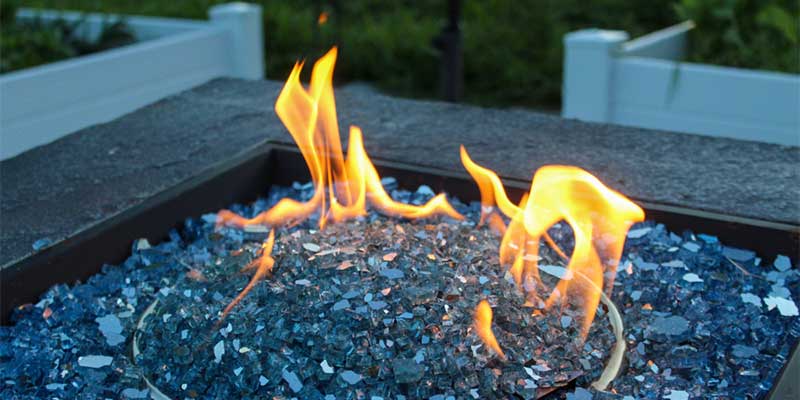
Introduction
Your indoor or outdoor fire pits always add a great addition to family events, parties, or small get-togethers. No matter if you are planning for a portable or permanent fire pit installation, you need to choose suitable rocks for your fire pit.
To do so, you need to be acquainted with the rocks in the first place. So, if that being said, what kind of rock do you use for a fire pit? Then, luckily, you are in the right place as this article contains all you will need about this topic.
Let’s get started!
4 Common Type of Rocks for Fire Pit
The inside of fire pits hold different types of rocks to get covered the inner workings of a gas line and also for decorative purposes. Let’s get to know about the most common 4 types of rocks that you can use for a fire pit.
Filler Rock
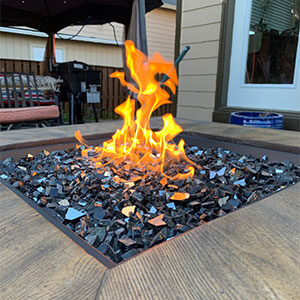 Fire pits need to form a base that is filled with an inexpensive filler- it will create a more expensive decorative option.
Fire pits need to form a base that is filled with an inexpensive filler- it will create a more expensive decorative option.
Filler rock materials are made from lava rock, volcanic ash, or silica sand- these will retain heat well as well as make your decorative rock way more efficient.
Lava rock is dark-colored and it is best used beneath dark materials (e.g black glass). We will talk more about lava rock later. Silica sands are in a variety of colors to contrast or complement with top materials or simply used alone, without any top material.
Fire Glass
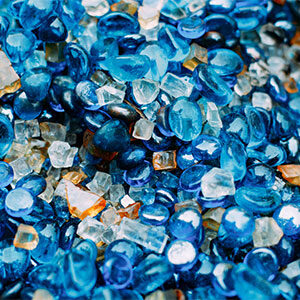
Fire glass is used for both aesthetic and functional purposes. The glass crystals work as an alternative to lava rock and this is especially suitable for gas fire pits. Since fire glass is Tempered glass (a type of safety glass), it will not soot, melt, soot, or explode (because it is manufactured at over 1200 degrees that resist melting and so on).
Moreover, the crystals of this glass are well-polished and tumbled. This means no sharp edges exist that may have the risk of cutting hands during handling the fire glass. But be careful of any poor quality version of fire glass. Because the poor versions contain plastic and laminate that can create poisonous fumes.
A point to be noted, propane gas fire pits can slightly discolor fire glass crystals day by day. So, using propane fire pits, black fire glass is recommended.
Lava Rock
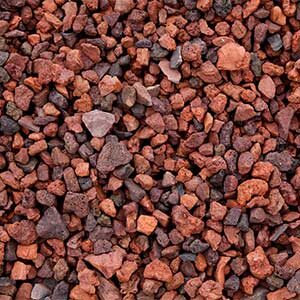 Lava rocks have a natural and rustic look. Also, they are less expensive. These rocks come in various colors (e.g red, brown, and gray shades), shapes, and sizes. Moreover, lava rocks are suitable for both indoor and outdoor natural gas or propane gas fire pits.
Lava rocks have a natural and rustic look. Also, they are less expensive. These rocks come in various colors (e.g red, brown, and gray shades), shapes, and sizes. Moreover, lava rocks are suitable for both indoor and outdoor natural gas or propane gas fire pits.
Lava rocks will even easily hide a fire pit burner ring. Fill the bottom of the firepits with different sizes of lava rock (start with 1-inch). For the spaces, fill them with ¼-inch lava rock as well as top it off using your favorite decorative glass, stone, or rock. However, smaller pieces of lava rocks disperse heat more evenly.
These rocks will create an appealing underlayment to wood logs as well as work for keeping the heat in the pit even longer than logs alone.
Although lava rocks require less maintenance, try to remove the rock from your fire pit once a year and rinse it off with clean water. In case, your lava rock is subjected to prolonged sun exposure, try to cover your fire pit when not in use.
River Rock
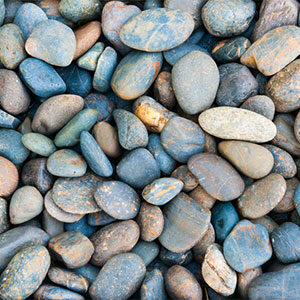 Hold on! This is not your ordinary rock from a river. To use in a fire pit, you have to collect manufactured ceramic fiber rock. These rocks come in multi-colors.
Hold on! This is not your ordinary rock from a river. To use in a fire pit, you have to collect manufactured ceramic fiber rock. These rocks come in multi-colors.
For this, the name ‘river rock’ originated from the fact that the colors of river rock are used in the manufacturing process.
Especially, for the outdoor living experiences on a balcony, a fire pit that is made of river rock is a great option.
Also, these rocks look elegant anywhere by giving natural and traditional looks. They even blend in very well with waterfalls and rock ponds.
What Types of Rocks Can Explode in Fire?
The one-worded answer is ‘wet’. Yes, although any kind of rocks contain the potential to explode- chances are more if these are porous and wet. Here’s how it happens- when a wet rock will heat up, the trapped air and water in it expand forcefully and very quickly that breaks the rock apart. Sometimes, this leads to causing it to explode.
For your kind information, the common rocks that you should avoid in a fire pit include gravel, limestone, sandstone, pumice, and also river rocks due to their tendency to hold water and porous nature.
On the other hand, some of the hard rocks including marble, granite, slate are less likely to hold water and explode while exposing to heat. Some other rocks that will be safer to use in and around your fire pits are- lava rocks, lava glass, poured concrete, and rate brick.
Remember, if there are rocks around or in your fire pit, be very cautious while lightning fires after it has rained. As we mentioned, wet rocks are way more likely to explode than the dry ones. Moreover, if you use your fire pit frequently, you may consider covering the fire pit in adverse weather for keeping it dry and more importantly, keeping yourself safer.
Can you use regular rocks in a fire pit?- Here’s Your Answer!
Before going to install a fire pit, you have to know about the ins and outs of it. Choosing and collecting the perfect rock is also a matter of concern. However, this is luckily something you don’t necessarily get wrong.
Because we are here to answer the question ‘can you use regular rocks in a fire pit?’ in a detailed manner so that you left no confusion regarding this topic at the end of this article.
So, without beating around the bush, let’s get into the main point.
Basic Types of Rocks
Igneous, Metamorphic, and Sedimentary are the three basic types of rock. Starting to talk about igneous rocks- they are the result of volcanic activity (throwing out hot lava) that finally cools to a solid rock.
When it comes to sedimentary rocks- they are the products of many layers of lake floor or lake sediment settling on 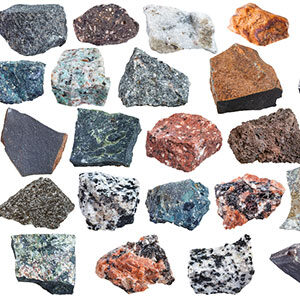 the ocean or simply the layers of the ocean. On the other hand, metamorphic rocks were once either sedimentary or igneous rocks and have been heated as well as compressed over time into something denser than the original rock.
the ocean or simply the layers of the ocean. On the other hand, metamorphic rocks were once either sedimentary or igneous rocks and have been heated as well as compressed over time into something denser than the original rock.
Also, the basic parts of this are hard rocks and soft rocks.
The most common examples of hard rocks are granite, slate, and marble whereas slate and marble are both metamorphic rocks. So, these rocks have been formed over a long time by the compression of limestone and shale. On the other hand, granite is an igneous rock and it was never exposed to water or air since it cooled down allowing it to solidify in a very dense form.
Common soft rocks are limestone, pumice, and sandstone. These are not as dense as the hard rocks, there are even more spaces in between the molecules that make up the stone. This feature makes them more permeable to water, softer, and lighter. Both limestone and sandstone are sedimentary rocks that were not formed with a great deal of compression.
A point to be noted, pumice rocks are also porous but are igneous rocks that form when volcanic lava is mixed with colored water or air. This feature forms bubbles that weaken the rock structure and make it very porous.
Why Choose Fire Rocks?
The rocks in a fire pit should be able to retain direct heat. Fire rock is a special kind of rock that is manufactured lava rock/volcanic rock that is used as a medium to retain direct heat. This is the main difference between regular rocks and fire rocks.
Fire rocks are mainly used in natural gas or propane-burning fire pits or natural gas fireplaces. Because fire rocks not only increase combustion efficiency but also maintain an aesthetic quality.
Moreover, fire rocks disperse the flame of the fire pit and fireplace well. Because these rocks allow the gaps that work as channels for gas and air to funnel the flame through.
So, to sum up, here you go with some important characteristics of fire rocks that are not contained in regular rocks:
- Ability to withstand a high temperature of direct heat
- Fire rocks are porous, this is why fire rocks do not explode like the river rocks or any other regular rocks
- If there’s any moisture in the fire rocks, the air pockets in the rocks will let the rock split easily when heated
- A lava rock with 3-4” of the solid layer within a fire pit works as a shield for the fire pit’s burner
What If You Use Regular Rocks In Your Fire Pit?
The regular rocks or river rocks that you have collected outdoors on your own, they contain moisture. For this, when heated, they tend to explode. You will never want this, right?
However, the other characteristics that we talked about before, regular rocks will not ensure you give those. Since fire pits are great for your friends and families to gather around. It is very selective about the rocks or wood whatever you are going to use. Because ensuring your place the utmost safety for them matters.
Benefits of Using Fire Rocks in Fire Pits
Since the inexpensive fire rocks are providing every positive output you need from a fire pit, why should you use regular rocks instead of them? Let’s have a look at the benefits of using fire rocks in fire pits.
- Fire rocks are very good at handling heat, also they can be both ‘weatherproofing’. And water-resistant for your fire pits plus their critical components.
- Once we mentioned above, the 3-4” layer of fire rocks (lava rocks) work as a shield for the fire pit’s burner. So, ultimately, they work as fire pit burner protectors from several elements.
- When you light a gas fire pit, the gas will fuel the flame on the surface by moving through blank spaces in the fire pit rocks.
At this time, the maximum amount of the flame and heat remains on the surface. Fire rocks have natural insulating power to shield the burner from the acute heat up. Top that makes it perform better over time and last longer.
- Fire rocks can evenly distribute as well as retain the heat. But the regular rocks can’t distribute and retain the flame and heat as the fire rocks can.
- Fire rocks are inexpensive, and gas fire pit rocks are even cheaper
- They are so durable. Fire rocks will not only do its job perfectly for a long time. But also will keep its natural color with just normal use.
- Best Rocks For Fire Pit Reviews and Buyer’s Guide
Conclusion
So, yes, this is all we kept for you. We hope that by reading this article. And you got your answers to what kind of rock do you use for a fire pit.
Firepit rocks are simple, cheap, and durable alternatives to any regular rock you may use for a fire pit.
However, considering your time, effort, and the quality of rocks for using in fire pits. So we recommend you to use fire rocks instead of the regular ones.
Do not forget to exercise precautions. Because just by taking a few extra precautions, you can spend quality time and simply enjoy the comforting blaze. Also, try to maintain the fire pit regularly. If you just put off important maintenance work for the next weekend, you will need to work harder.
Now, you know about the rocks of a fire pit, go ahead and choose one that fits for you. Good luck!




